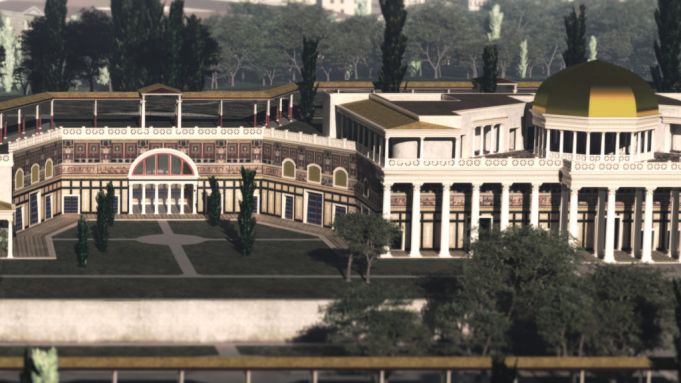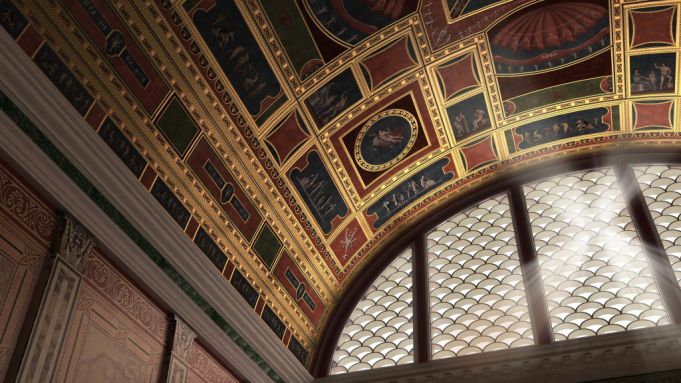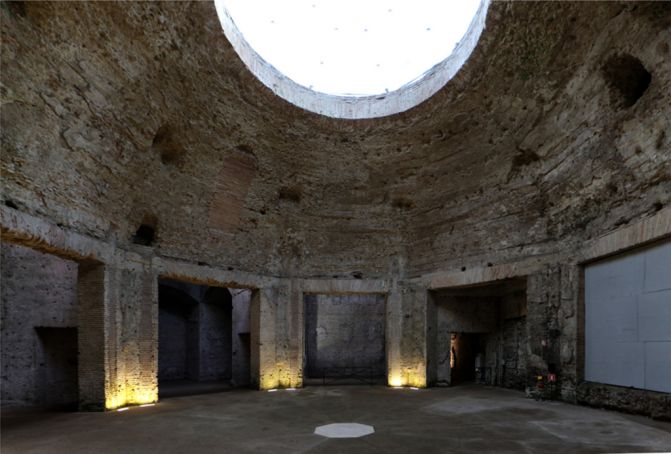Virtual reality transports visitors to the opulent past of Rome's Domus Aurea.
The Domus Aurea as You've Never Seen it Before is the name of the new virtual reality experience awaiting visitors to the recently re-opened “Golden House”. However, it would be equally appropriate to call it The Domus Aurea as Nero Saw It.
Thanks to years of dedicated work by archaeologists and restorers, and with the added magical touch of today's high tech, a visit to the ruined palace on the Colle Oppio has been transformed from a rather dry tour of empty halls and faded frescoes into a fascinating event that brings the past vividly and visibly to life.
Unless you have an archaeologist's eye and an exceptional gift of imagination, the palace, seen in the nude, looks pathetically bleak – a tortuous maze of rambling underground corridors and rooms. It has preserved very little of its original glory, when it was described by the Roman satirist, Suetonius: “The entrance-hall was large enough to contain a huge statue of himself [i.e., Nero], 120 feet high … and the pillared arcade ran for a whole mile. An enormous pool, like a sea, was surrounded by buildings made to resemble cities, and by a landscape garden … Parts of the house were overlaid with gold and studded with precious stones and mother-of-pearl. All the dining-rooms had ceilings of fretted ivory, the panels of which could slide back and let a rain of flowers, or of perfume from hidden sprinklers, shower upon his guests.”
Whether or not Nero was actually responsible for the fire of Rome, he certainly took advantage of all the space cleared to build himself a pleasure dome that remained a legend.
Domus Aurea after Nero
After the allegedly mad Nero committed suicide, the palace was stripped of all its costly marbles and adornments. Trajan, who succeeded as emperor after a series of short-lived rulers, built his equally sumptuous baths on top, filling in the once magnificent halls and corridors with rubble. Ironically, his action saved it for future generations.
The Domus Aurea was originally a gigantic estate occupying 80 hectares and spread over the three hills that dominated the valley where the Colosseum was constructed a few years after Nero's death. Some 16,000 sqm have been excavated, with a total 150 rooms. However, archaeologists claim that this is only 50 per cent of the entire complex. The other half now lies under the streets and buildings of the modern city and is therefore inaccessible.
Apparently, the palace was not constructed as an actual residence. No heating pipes or other typical Roman mod cons have been discovered. There is no evidence either of the revolving dining-room roof described by Suetonius.
“This may have actually been in the imperial palace on the Palatine Hill,” explains Elisabetta Segala, a member of the restoration team. “The Domus Aurea was probably more of a show place, a flagrant display of wealth and power, where Nero could entertain and impress guests.”

The present tour begins with a 3D projection on the walls of the entrance, giving us a brief history of the monument from the fire of Rome to world war two, where footage from the historic archives of the Cinematography Istituto Luce show the galleries converted into shelters for the homeless.
Work is still in progress, so we don safety helmets to enter the maze of passages that run the entire length of the excavated monument. Trajan oriented his baths differently from the Domus, so the foundations for his buildings divide up many of the rooms, creating odd angles. As we proceed it seems impossible to believe that these dank, dark surroundings were once flooded with light and colour.

The revelation awaits in the Room of the Gilded Ceiling, the new heart of the tour. We sit on benches looking onto a landfill wall, which, when we use our stereoscopic visors (or head-mounted display devices, as they are called officially) becomes transformed into first, a vast cave, and then an open portico. The “cave” or “grotto” was accessed through a hole in the roof by Renaissance artists like Raphael, Pinturicchio, Ghirlandaio and Giulio Romano, who all re-discovered the amazing frescoes by Nero's top artist Fabullo, thus creating a fashion in “grotesques” that influenced the interior decoration of noble houses for the following three centuries.
Golden House in Nero's day
The show continues with a virtual trip back to the Golden House in Nero's day. The rubble melts away. We are in a room filled with light. All around, the walls and ceiling are covered in brilliantly coloured designs, stucco work and gilding. Next, we are lifted suddenly on a magic carpet ride through the columns of the Great Cryptoportico and out into the garden, where we float to the edge of the Pentagonal Courtyard to look down on the lake far below.
Leaving behind the virtual glimpse into the past, the tour continues through a succession of rooms, including the Room of Achilles on Skyros, where it is just possible to make out the hero hidden among the women, the recently opened Room of Hector and Andromache, the Room of the Red Ceiling, the Room of the Yellow Ceiling (where Pintoricchio has written his name on the wall) and the Room of the Owl, to end at the vast and splendid Octagonal Hall with the “eye” in the dome open to the sky. This room gave Bramante his inspiration for the design of the Octagonal Courtyard in the Vatican.

The problem of damp and decay becomes even more poignant after we have seen what the original decorations once looked like. The few frescoes left are very faded and are being steadily eaten away by calcium deposits seeping through from the soil overhead.
The Domus Aurea, in fact, is covered over by a park, created in 1936 when the Via del Monte Oppio was laid through the middle of the ruins of Trajan's baths. The park has trees that have grown to monumental size, with spreading roots that penetrate the very ceilings of the Golden House, seriously compromising its stability.
Landscape architect Gabriella Strano took us up to the park to see how the problem is being tackled. She pointed out the trunks of two felled holm oaks. “They couldn't be uprooted by mechanical means without damaging the Domus,” she explained. ”The job had to be done manually with great care.”
Tree roots
She pointed to a colossal Roxbourgii pine: “That will also have to go. It grows right on top of the Nymphaem of Ulysses and Polyphemus and it weighs five tons. The roots are endangering the mosaic featuring the myth as well as the other decorations of seashells and imitation stalactites – that was a favourite theme of the Romans, then copied in many Renaissance palaces.
“The weight of earth on the Domus roof is between 2,500 – 3,000 kg per sqm. It has to be lightened or the ceiling will eventually collapse,” she continued. It says a lot for Roman building skills that the Golden House has survived, denuded but intact, to the present day.
Ongoing works
Works is underway to replace the present park with a garden that would not put the monument at risk. The heavy layer of soil is being removed and replaced with a lighter stratum of earth, spread over a state-of-the-art waterproof base and drainage system. The pilot project, completed last spring, is based on a typical ancient Roman garden as described by writers like Pliny and Columella, with rectangular beds in box borders, set in geometrical patterns and blooming with the kind of flowers and plants popular in the Roman era such as lavender, periwinkles and rosemary. In place of trees there are potted shrubs.
The layout of the entire garden area will trace the outlines of the rooms below, while the oculus in the dome of the Octagonal Hall will be left uncovered, with the installation of an inclining panel in reflecting steel to protect it from the elements.
Eventually, the Domus Aurea will have a complete roof garden. Even Nero never dreamt of this.
Margaret Stenhouse
The Domus Aurea is open on Sat-Sun 09.15-15.30. Maximum 25 people admitted every 15 mins. Prior booking essential. Tours available in Italian, English, Spanish and French. For information and bookings tel. 0639967700 or see website www.coopculture.it.
This article was published in the May 2017 edition of Wanted in Rome magazine.





















